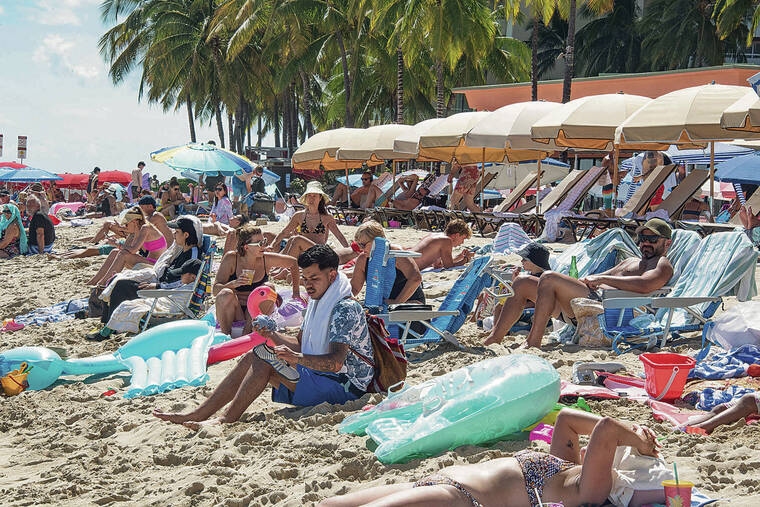Even though April was the best month for overall visitor arrivals since the pandemic began, arrivals from Hawaii’s core domestic market fell for the first time since December and cast a possible shadow on the path forward.
Some 827,537 visitors came to the Hawaiian Islands in April, an increase of 1.1% from arrivals in April 2022, according to preliminary visitor statistics released Tuesday by the Department of Business, Economic Development and Tourism.
When compared with pre-COVID-19 April 2019, April’s arrivals recovery represented a 97.4% recovery. The visitors who came to Hawaii in April spent more on a nominal basis than visitors who came in 2022 and in 2019. Visitor spending in April topped $1.72 billion, a nominal increase of 8% from April 2022 and 30.7% from April 2019.
DBEDT Director James Kunane Tokioka said in a statement, “April marked the 24th consecutive month where visitor arrivals from the U.S. mainland exceeded 2019 monthly levels for those respective months. April U.S. visitor arrivals were 19% higher than the same month in 2019.”
However, April did show some concerning year-over-year pullback from Hawaii’s core U.S. West visitor market, which at 514,878 arrivals was down 9.7% from April 2022 but up 19.7% from April 2019.
Hawaii’s second-largest visitor source market, the U.S. East, was down 1.2% from April 2022 to 188,868 arrivals but up 17.3% from April 2019.
U.S. West visitors’ spending of $874.4 million in April declined 7.1% from April 2022 but was 59.8% higher than April 2019. U.S. East visitor spending increased 11.9% to $473.2 million in April and was up 65% from April 2019.
Domestic travelers, so far, have carried Hawaii tourism through its pandemic recovery. Having a mix of visitors to balance expected declines from the U.S. will be important to Hawaii’s visitor performance in 2023 and 2024.
Jerry Gibson, president of the Hawaii Hotel Alliance, said, “The U.S. has really been the only place that Hawaii is getting tourists from, so when that slows down you get what we are seeing: a much slower pace for summer.”
Gibson said the hotel industry is very concerned about the drop from the U.S. and hopes that once the debt ceiling issue is resolved that additional pickup might materialize. But he added, “This could be one of those years like 2007 that just didn’t end well. It’s one of the very few years in the last 16 or so that feels like it just won’t come through for us. If you were to look at it now, you would feel that way.”
To be sure, the University of Hawaii Economic Research Organization’s
second-quarter forecast released in April indicates that while the U.S. market still dominates, it is expected
to “soften as the year
progresses.”
The UHERO forecast said, “Further international market recovery will sustain visitor numbers. Lagging Japanese travel will continue to be a problem.”
Tokioka said, “It will take a while for the international visitor arrivals to recover to pre-pandemic levels. The recovery of international markets this April was at 55.8% and Japanese arrivals were at 28.8% of the April 2019 levels. “
Japan, which was Hawaii’s top international market prior to the pandemic, was still far off recovery in April. Only 34,358 visitors came from Japan in April, compared with 6,749 visitors in April 2022 and 119,487 visitors in April 2019. Visitors from Japan spent $57.3 million in April, up 274.1% from April 2022 and down 65% from April 2019.
Gibson said, “I don’t think Japan will be all the way back until June of 2024.”
April arrivals from Canada, one of Hawaii’s most mature international markets, reached 43,107, a decline of 8.8% from April 2022 and 30.7% from April 2019. Visitors from Canada spent $96.3 million in April, up 8.5% from April 2022 and down 3.8% from April 2019.
April arrivals from the category “All Other International Markets,” which includes nations outside of the U.S., Canada and Japan, reached 80,708 visitors, up 44.1% from April 2022 and down 19.8% from April 2019. Visitor spending for this category reached $212 million, an increase of 70.8% from April 2022 and up 1.1% from April 2019.
It was notable that in the past, international visitors often spent the most on a daily basis, but in April, U.S. East visitors spent the most at $278 per day and U.S. West visitors spent $233 per day, which was almost to the level of visitors from Japan, who spent more than $235 per day. Visitors from the “All Other International Markets” category spent more than $248, and visitors from Canada spent more than $216.
The change in daily spending rankings could be related in some cases to unfavorable foreign exchange rates. However, the Hawaii Convention and Visitors Bureau, the nonprofit that holds the U.S. tourism contract for the Hawaii Tourism Authority, has been focusing on targeting higher-spending U.S. visitors in its marketing and branding campaigns.
Keith Vieira, principal of KV &Associates, Hospitality Consulting, said HVCB’s work has helped Hawaii’s domestic tourism to grow through spending rather than arrivals.
HTA recently selected HVCB for a nearly $38.4 million multiyear contract to continue branding and marketing Hawaii to U.S. visitors; however, another offeror has requested a debriefing of the procurement selection, which does not become final until it passes the June 14 deadline for that offeror to file a protest.
Vieira said continued uncertainty over the U.S. marketing contract, which has been in upheaval since 2021, ultimately could hurt Hawaii tourism, which is
extremely reliant on U.S. visitors.
“We are seeing definite softness. It really starts in May and goes throughout the rest of the year,” Vieira said.

